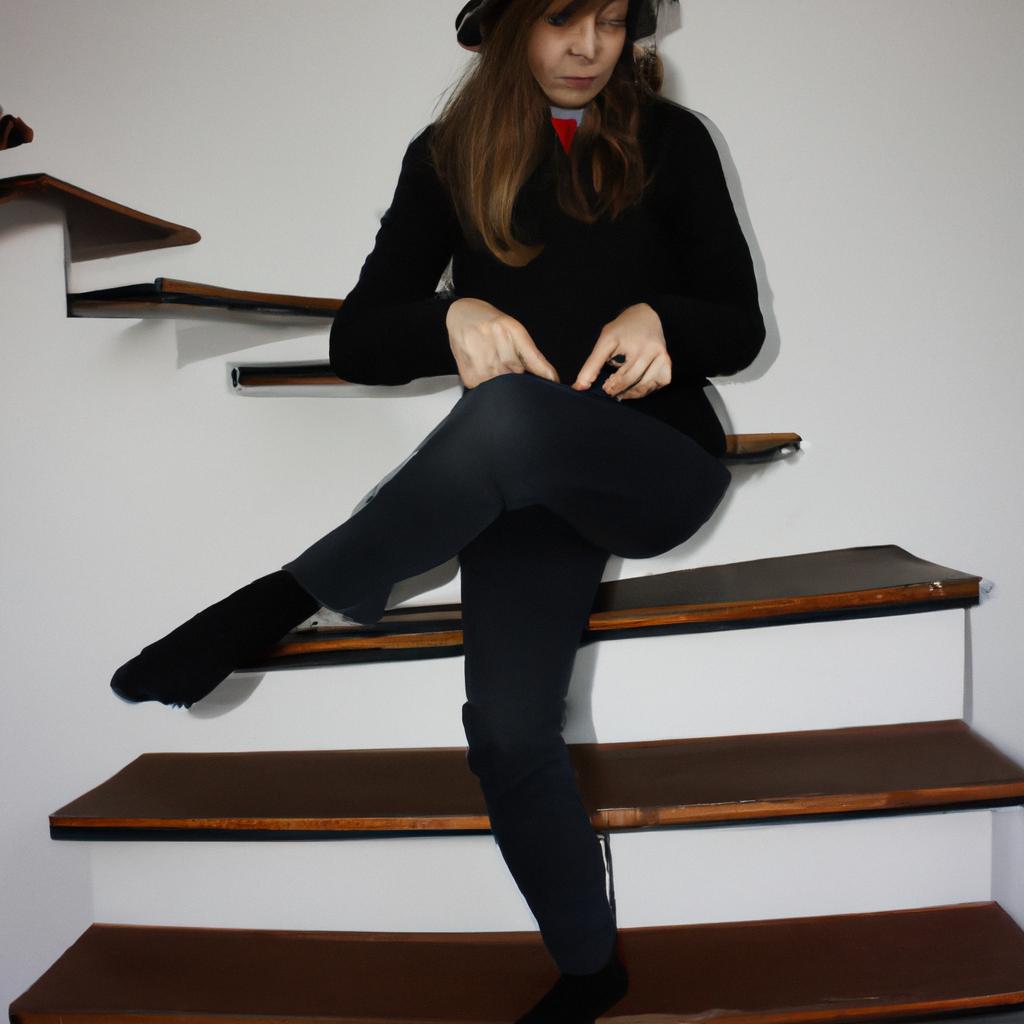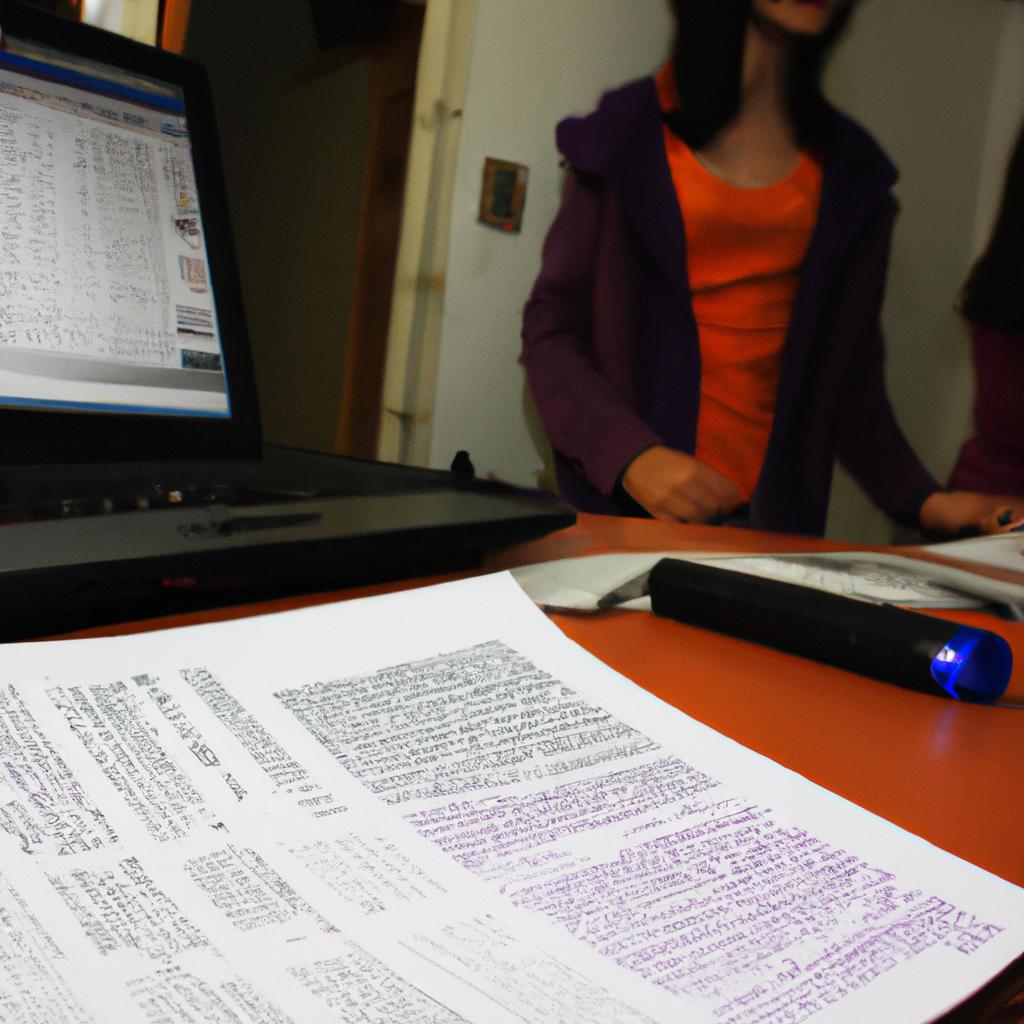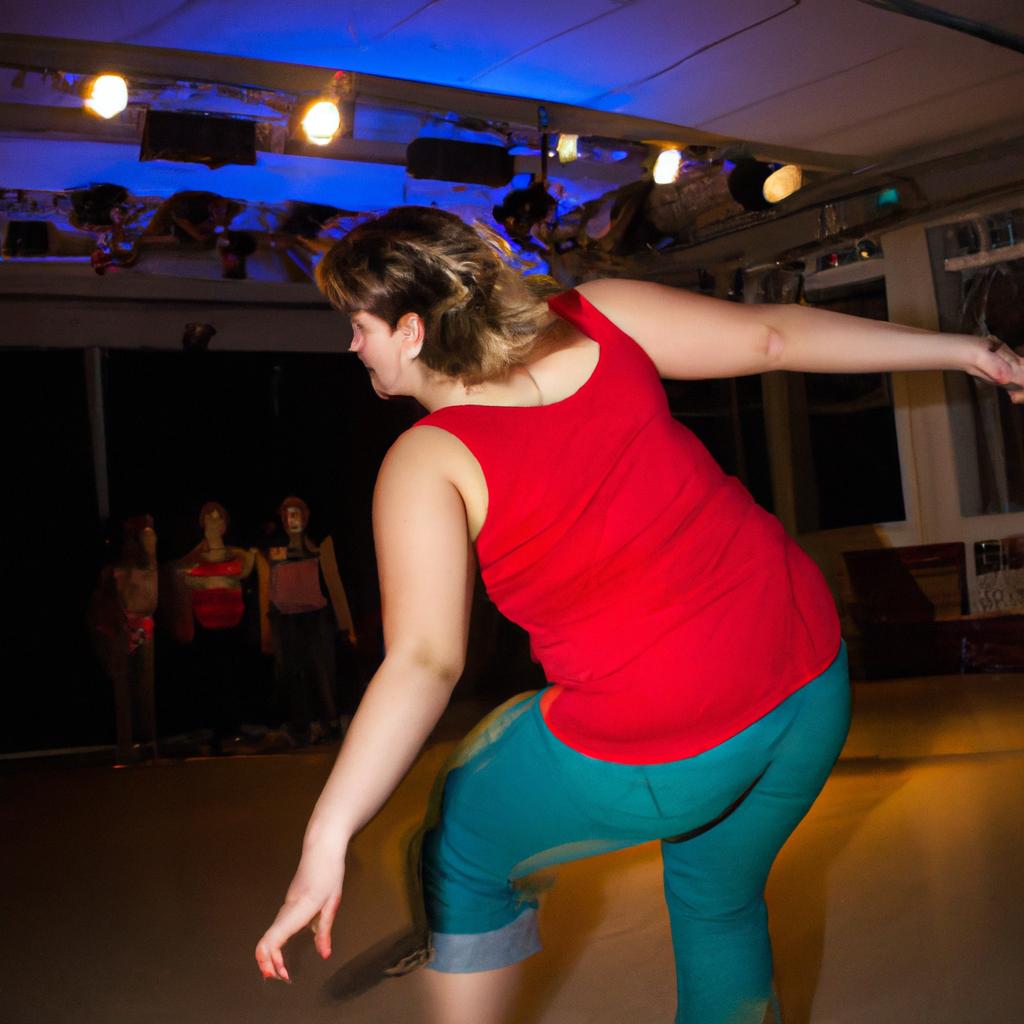Stagecraft and Actress: The Theatrical Techniques

The art of stagecraft and its interplay with actress performance is a captivating subject that has been studied extensively in the realm of theatre studies. The effectiveness of theatrical techniques utilized by actresses is crucial in creating an immersive experience for the audience, enabling them to suspend disbelief and become fully engaged in the narrative. For instance, consider the case study of Emma Thompson’s portrayal of Blanche DuBois in Tennessee Williams’ “A Streetcar Named Desire.” Through her masterful use of vocal modulation, body language, and strategic movements on stage, Thompson was able to convey the complexities of Blanche’s character, drawing viewers into a world where illusion and reality intertwine.
Understanding how stagecraft works hand-in-hand with an actress’s performance requires delving into various elements such as set design, lighting, sound effects, costumes, makeup, and props. These components are meticulously chosen to enhance the actors’ abilities to communicate their characters’ emotions, motivations, and intentions effectively. By employing these techniques strategically throughout a performance, actresses can manipulate their physicality and create dynamic relationships within scenes while also emphasizing key moments or themes within a play.
Moreover, stagecraft allows an actress to establish a strong presence on stage through intentional blocking and movement choices. Carefully choreographed entrances and exits, as well as the positioning of actors within a scene, can significantly impact the audience’s perception of a character and their relationships with other characters. By using specific movements and gestures, an actress can convey power, vulnerability, or any range of emotions to further develop their character and advance the plot.
In addition to physicality, vocal techniques play a crucial role in an actress’s stagecraft. The way lines are delivered – through tone, volume, pace, and emphasis – can profoundly influence the audience’s understanding and emotional connection to the story. A skilled actress knows how to modulate her voice to reflect her character’s state of mind, allowing for deeper engagement and empathy from the viewers.
Collaboration is also vital in the interplay between stagecraft and actress performance. Directors work closely with actresses to ensure that their vision for a production aligns with the intended artistic goals. Through rehearsals and discussions, directors guide actresses in exploring various choices regarding movement, vocal delivery, and overall interpretation of their characters.
Ultimately, when stagecraft is seamlessly integrated with an actress’s performance, it creates a cohesive theatrical experience that transports audiences into another world. The combination of technical elements and skillful acting allows for a powerful connection between performers and spectators – an exchange of energy that makes theatre such a unique form of storytelling.
Historical Background
Throughout history, the art of stagecraft has played a pivotal role in theatrical productions. From ancient Greek tragedies to modern-day Broadway performances, the techniques employed by actors have evolved and adapted to suit various artistic movements and cultural contexts. Understanding the historical background of stagecraft is crucial for appreciating its significance in shaping the world of theater.
To illustrate this point, let us consider a hypothetical scenario: an aspiring actress named Emily embarks on her journey into the realm of performing arts. As she delves deeper into her craft, she discovers that behind every captivating performance lies a rich history of theatrical techniques. This realization prompts Emily to explore how these techniques have developed over time and influenced the work of renowned actresses throughout history.
One way to understand the evolution of stagecraft is through examining key aspects that have shaped it across different eras. Here are four noteworthy elements:
- The use of masks: In ancient Greek theater, masks were worn by actors as a means to project emotions and differentiate characters. These expressive tools enabled performers to reach larger audiences while maintaining clarity in storytelling.
- The emergence of naturalism: During the late 19th century, naturalistic acting styles sought to portray realistic human behavior on stage. Actors focused on conveying genuine emotions and reactions, often drawing inspiration from everyday life.
- The influence of method acting: Developed in the early 20th century by Constantin Stanislavski, method acting emphasized an actor’s immersion into their character’s psyche. It encouraged deep emotional exploration and personal connections with roles.
- Technological advancements: With innovations such as lighting design, sound engineering, and special effects, theater transformed dramatically during the 20th century. These technical developments allowed for more immersive experiences and expanded creative possibilities.
To further visualize this progression, here is a table highlighting notable examples from different periods:
| Period | Notable Actress | Contribution |
|---|---|---|
| Ancient Greece | Thespis | Introduced the concept of individual characters on stage |
| Elizabethan Era | Sarah Bernhardt | Revolutionized acting with her expressive and bold portrayals |
| Realism Movement | Eleonora Duse | Pioneered naturalistic acting styles |
| Modern Theater | Meryl Streep | Known for her versatility and ability to embody diverse roles |
As we explore the historical development of stagecraft, it becomes evident that each era has left a distinct mark. This background knowledge serves as a foundation for understanding how actresses have adapted to changing theatrical techniques over time.
Transitioning into the subsequent section about “Character Development,” it is important to delve further into the role that these techniques play in shaping both the portrayal and transformation of characters on stage.
Character Development
Section H2: Character Development
Building upon the historical background of stagecraft, character development plays a pivotal role in bringing theatrical performances to life. Through various techniques and methods, actors strive to create believable characters that resonate with audiences. To illustrate this point, let us consider the case study of Emma Thompson’s portrayal of Elinor Dashwood in the film adaptation of Jane Austen’s “Sense and Sensibility.”
One essential aspect of character development is understanding the psychology behind each individual portrayed on stage or screen. Actors delve into their characters’ backgrounds, motivations, and desires to develop a deep understanding of their psyche. By doing so, they can authentically convey complex emotions and thought processes.
To effectively portray a character, actors often utilize physicality as a means of expression. Movement, gestures, and body language all contribute to conveying the essence of a character. For example, an actor might adopt a distinctive gait or posture to communicate specific traits or personality quirks.
In addition to psychological and physical aspects, vocal techniques also play a significant role in character development. The way an actor uses their voice – tone, pitch, volume – helps shape both the personality and emotional state of their character. A powerful monologue delivered with conviction can evoke strong emotions from the audience.
Character Development:
- Immerse oneself in extensive research about the character’s background
- Develop an understanding of the character’s motivations and desires
- Utilize physicality through movement, gestures, and body language
- Employ vocal techniques to convey emotions and personality traits
Table: Techniques for Character Development
| Technique | Description | Example |
|---|---|---|
| Psychological Analysis | Delving into a character’s inner thoughts and motivations | Understanding how past trauma shapes behavior |
| Physical Transformation | Adopting distinct postures or mannerisms that reflect the character’s unique qualities | Slouching shoulders to convey a defeated attitude |
| Vocal Modulation | Manipulating tone, pitch, and volume of the voice to reflect different emotions and personality traits | Speaking softly to portray vulnerability |
| Observation | Studying real-life individuals or observing human behavior in various contexts to inform character development | Watching people at a café to capture natural gestures |
In conclusion, character development is an integral part of stagecraft that involves delving into deep psychological analysis, utilizing physicality, and employing vocal techniques. By understanding their characters on multiple levels, actors can create compelling performances that resonate with audiences.
Moving forward from exploring character development, we now turn our attention to another crucial aspect of theatrical techniques – voice and speech.
Voice and Speech
Section H2: Character Development
In the previous section, we explored the process of character development in stagecraft. Now, let us delve into another crucial aspect of theatrical techniques – Voice and Speech. To better understand its significance, let’s consider a hypothetical case study:
Imagine an actress preparing for the role of Lady Macbeth in Shakespeare’s famous tragedy “Macbeth.” Through careful analysis of the text and thorough research on the character, she begins to shape her interpretation. However, without proper vocal training and command over speech techniques, her portrayal may fall short of delivering the complexity and depth required for such a complex role.
Voice and speech are essential tools that enable actors to effectively communicate their characters’ emotions, intentions, and personalities to audiences. Here are some key points to consider when exploring this area:
- Breath control: Mastering breath control allows actors to project their voices clearly and sustain long speeches or monologues.
- Articulation: Precise articulation ensures that every word is intelligible even in large theater spaces.
- Tone and pitch: Understanding how tone and pitch can be modulated helps convey different moods and emotions accurately.
- Diction: Clear diction enhances clarity without sacrificing naturalness.
To illustrate further, let’s examine a table showcasing how voice and speech techniques contribute to character portrayal:
| Technique | Purpose | Example |
|---|---|---|
| Breath Control | Maintain vocal power during lengthy dialogues | Sustaining the intensity in a powerful soliloquy |
| Articulation | Ensure clear delivery of lines | Enunciating each word distinctly in comedic timing |
| Tone and Pitch | Convey emotional nuances | Shifting from anger to vulnerability within a scene |
| Diction | Enhance clarity while maintaining authenticity | Pronouncing regional accents authentically |
By honing their voice and speech skills, actors can bring characters to life in a way that captivates and engages audiences. This mastery allows for the effective communication of emotions, thoughts, and intentions through vocal expression alone.
Transitioning smoothly into the subsequent section about Movement and Physicality, we will explore how an actor’s physicality on stage complements the development of character and enhances storytelling.
Movement and Physicality
Building upon the foundational skills of voice and speech, the next crucial aspect in stagecraft is movement and physicality. By harnessing their bodies as a means of expression, actors are able to create vivid characters that captivate audiences. In this section, we will explore various techniques through which performers can effectively utilize movement and physicality on stage.
Paragraph 1:
To illustrate the significance of movement and physicality, let us consider the case of Anna, an aspiring actress who struggles with portraying confidence in her performances. Through extensive training in movement techniques such as Laban Movement Analysis and Viewpoints, Anna learns how to use her body language to convey strength and assertiveness. This newfound understanding allows her to command attention on stage and embody characters with conviction.
Paragraph 2:
Effective use of movement and physicality involves a range of elements that contribute to the overall performance. These include:
- Body posture: The way an actor holds themselves conveys subtle cues about their character’s personality or emotional state.
- Gestures: Purposeful movements of the hands or arms can enhance communication and add depth to a character’s portrayal.
- Facial expressions: Expressive faces can communicate emotions more powerfully than words alone.
- Spatial awareness: Understanding how to navigate the stage space helps actors make deliberate choices regarding proximity, creating dynamic relationships between characters.
- Increased self-awareness
- Enhanced storytelling abilities
- Heightened sense of embodiment
- Improved connection with fellow cast members
Table (3 columns x 4 rows):
| Techniques | Benefits | Examples |
|---|---|---|
| Laban Movement | Fluidity in motion | Graceful dance sequences |
| Analysis | ||
| Viewpoints | Ensemble coordination | Synchronized group scenes |
| Body Language | Authentic character portrayal | Convincing physicality |
Paragraph 3:
By honing their movement and physicality skills, actors are able to breathe life into their characters and create compelling performances. The integration of body language with voice and speech adds depth and nuance to the overall theatrical experience. As we move forward in our exploration of stagecraft, we will now delve into the crucial role that stage lighting plays in enhancing a performance.
With an understanding of how movement and physicality can enrich an actor’s performance on stage, let us now turn our attention to the transformative power of stage lighting.
Stage Lighting
Section H2: Stage Lighting
In the previous section, we explored how movement and physicality play a crucial role in stagecraft. Now, let us delve into another essential aspect of theatrical techniques: stage lighting. To illustrate its significance, consider a hypothetical scenario where an actress is performing a monologue on a dimly lit stage. The absence of proper lighting not only diminishes the visibility but also fails to create the desired ambiance for the performance.
Stage lighting serves as a powerful tool that enhances the overall atmosphere of a production while guiding the audience’s attention towards specific elements or characters on stage. Here are some key points to understand about this essential element:
- Mood-setting: Effective use of lighting can evoke emotions and set the mood for each scene. By employing different colors, intensities, and angles, lighting designers can create various atmospheres ranging from suspenseful and mysterious to cheerful and romantic.
- Focus control: Properly directed light draws attention to certain areas or actors on stage while leaving others in shadow. This technique helps guide the audience’s gaze and emphasizes particular actions or dialogue exchanges.
- Time and place: Appropriate lighting choices help establish the time period and location of a performance. For instance, warm golden hues may transport viewers to a sunny afternoon in ancient Rome, whereas cool blue tones could suggest a moonlit night in modern-day New York City.
- Symbolism: Lighting can be used symbolically to represent abstract concepts or themes within a production. For example, stark contrast between darkness and brightness might reflect inner turmoil versus enlightenment experienced by a character.
To further comprehend these principles, here is an illustrative table showcasing different types of stage lighting commonly employed:
| Type | Description | Effect |
|---|---|---|
| Floodlights | Wide-angle lights illuminating large areas | Creates uniform wash |
| Spotlights | Narrow beams focusing on specific subjects | Draws attention |
| Gobos | Stencils used to create patterned lighting | Conveys texture/theme |
| Color filters | Transparent sheets altering light’s color | Enhances mood/atmosphere |
In conclusion, stage lighting is an indispensable element in theatrical productions. Its ability to influence the audience’s emotions and perceptions cannot be overstated. By skillfully manipulating different lighting techniques, theater practitioners can bring performances to life by illuminating the narrative, creating atmosphere, and guiding the viewers’ focus. As we move forward into our next section about “Costume and Makeup,” let us explore how these elements further contribute to the overall visual impact of a production.
As we shift our focus towards “Costume and Makeup,” let us now examine how these aspects play a vital role in bringing characters to life on stage.
Costume and Makeup
With the stage lighting setting the mood and highlighting key elements of a performance, costume and makeup play an equally crucial role in bringing characters to life on stage. Through careful consideration of wardrobe choices and skillful application of cosmetics, actors can transform themselves into the embodiment of their respective roles. This section will explore how costume and makeup contribute to the overall theatrical experience.
Section:
One example that demonstrates the impact of costumes and makeup is Shakespeare’s tragedy “Macbeth.” In this play, Lady Macbeth’s character undergoes a visible transformation over the course of the story. At first, she appears regal and sophisticated, wearing elegant dresses with intricate details that reflect her position as nobility. However, as guilt consumes her, her appearance changes dramatically. Her clothes become disheveled, signifying her mental descent into madness. Additionally, through strategic use of makeup techniques such as darkened eyes and pale complexion, Lady Macbeth’s physical transformation further emphasizes her inner turmoil.
To fully appreciate the significance of costume and makeup in theater, consider these emotional responses they evoke:
- Creates a sense of authenticity by visually aligning characters with their time period or cultural background.
- Enhances believability by emphasizing certain traits or attributes associated with specific characters.
- Evokes nostalgia or sentimentality through familiar visual cues that resonate with audiences.
- Establishes hierarchy or power dynamics among characters through variations in clothing styles or accessories.
Furthermore, let us examine a table showcasing notable examples where costume and makeup have played pivotal roles in defining iconic theatrical characters:
| Character | Play | Notable Costumes | Memorable Makeup |
|---|---|---|---|
| Elphaba | Wicked | Black hat & cape | Green skin |
| The Phantom | The Phantom of the Opera | Masquerade costume | White half-mask, pale complexion |
| Willy Wonka | Charlie and the Chocolate Factory | Colorful suit | Eccentric hairstyle |
| Cleopatra | Antony and Cleopatra | Exquisite gowns & headdresses | Elaborate eye makeup |
As illustrated in these examples, costumes and makeup are instrumental in capturing the essence of a character, allowing audiences to connect with them on a deeper level.
In summary, costume and makeup serve as important tools for actors to visually communicate their characters’ traits, emotions, and journey. By carefully selecting appropriate attire and employing skillful cosmetic techniques, theater practitioners can create memorable performances that transport audiences into different worlds. Through authenticity, believability, nostalgia, and power dynamics established by wardrobe choices and makeup application, costuming enhances theatrical experiences while eliciting emotional responses from viewers.






